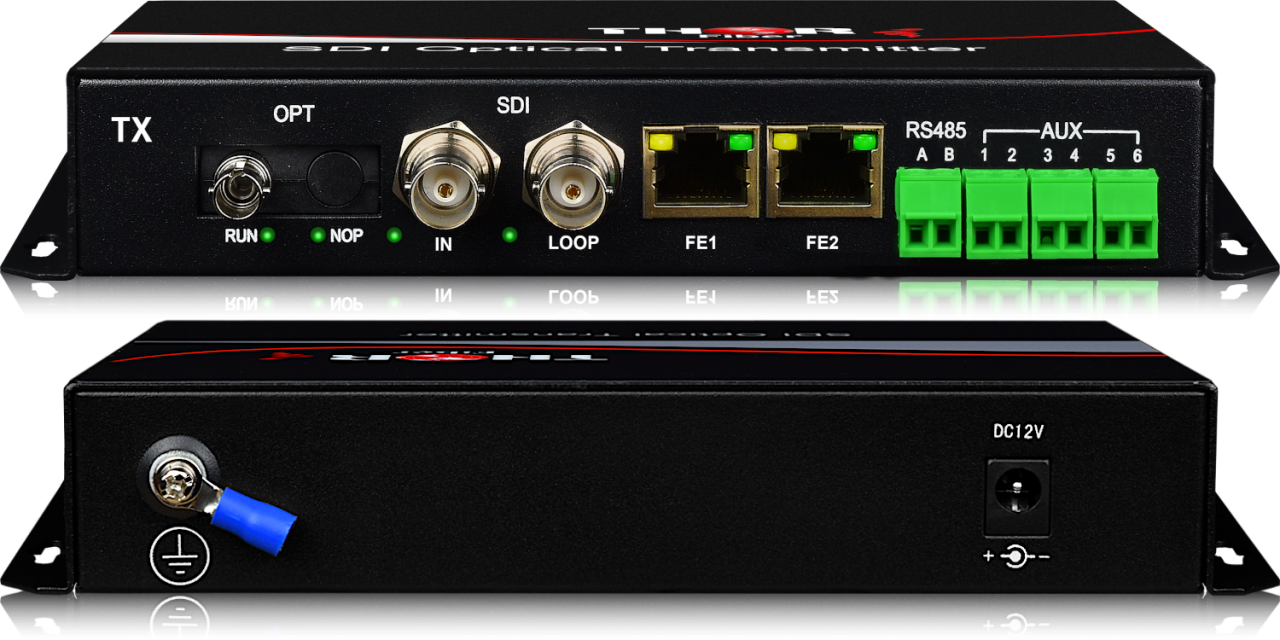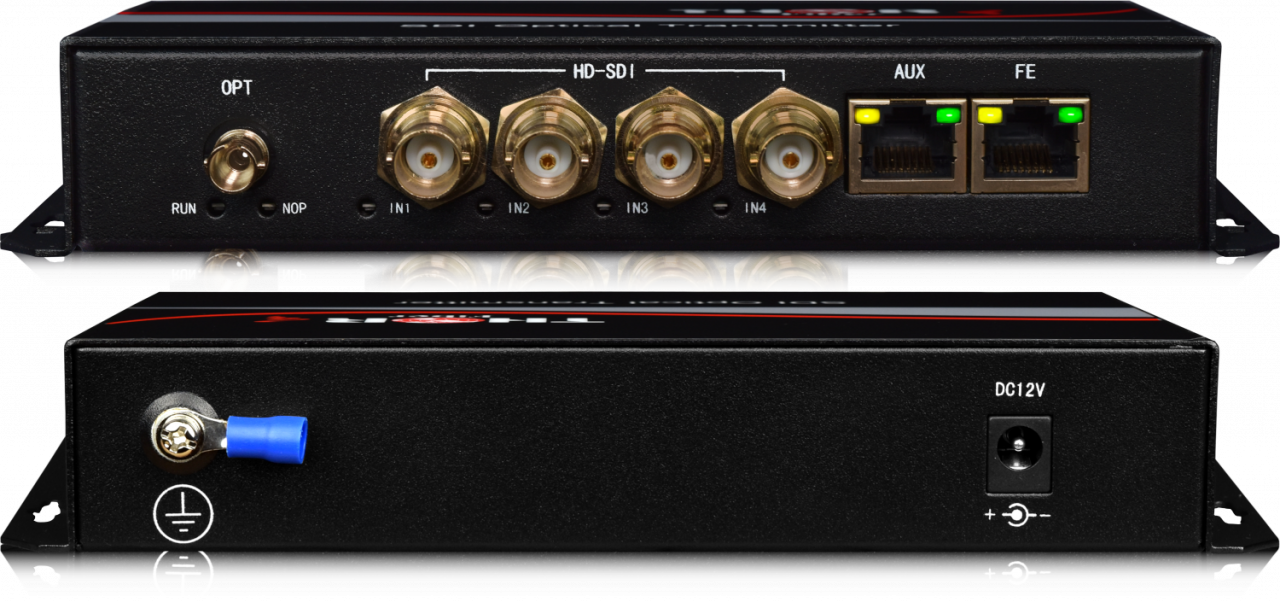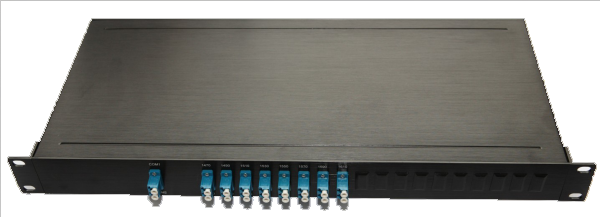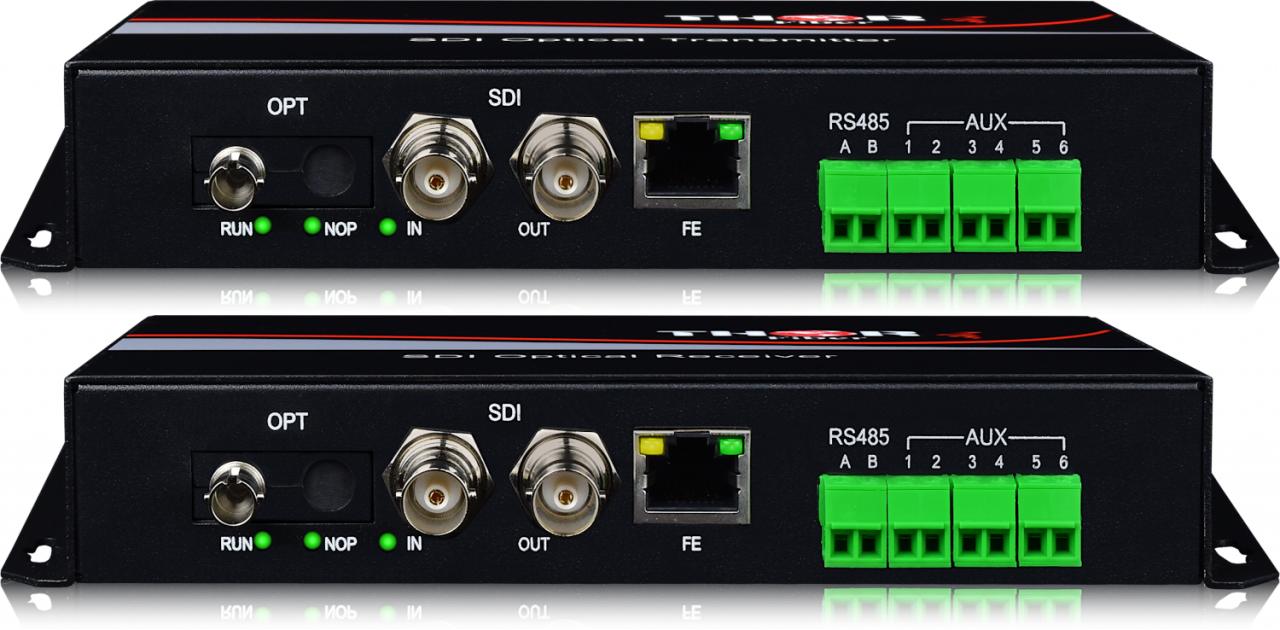This Device is 8 channel baseband video with 16 Channel Audio Transmission to fiber multiplexer. This Unit provides optical transmission for distances from 20Km up to 120Km singlemode or 2000ft multimode over fiber optic cable.
Features
• 8 Channel Baseband Video Transmission
• 16 Audio Channels
• Video Over Fiber for distances up to 120 Km (20km standard)
• High Quality 10-bit Digital Video Sampling
• Field Expandable to 16 Video/32 Audio
• 67dBSNR
• Bidirectional Transmission available
• CWDM 1470nm,1490nm,1510nm,1530nm,1550nm,1570nm,1590nm,1610nm (optional)
• DWDM ( optional )
This device is a Wavelength division multiplexer for WDM, CWDM or DWDM applications. This unit also can customize our equipment for use with these optics.
Features
Extend 8 HD-SDI/SD-SDI signals over long distances via Single Mode Fiber. Features RS-485 return, audio, RS-232/RS-422, and contact closure
Features
- Supports 8 Full HD-SDI @ 1.5Gbps or lower SDI
- Transports embedded 2 audio channels on each SDI signal
- Return path serial RS-485 channel for controlling equipment on Tx end
- Link alarm indicators on both Tx & Rx indicate a problem with the fiber
Send SDI over fiber in both directions and Ethernet at the same time
Features
- Compliant with SMPTE-292M HD-SDI and SMPTE-259M SD-SDI standard, supports 1.485Gb/s and 270Mb/s
- One SD/HD-SDI input (BNC), one SD/ HD-SDI output(BNC) and one fast Ethernet interfaces
- Supports 1080P@30,25,24, 29.97 / 1080I@60,50,59.94 / 720P@60,50,30,25,24, 59.94, 29.97, 23.98 and 625i / 525i format,
- When input is [email protected], 23.98 / [email protected] / [email protected], 29.97, 23.98, the output is 1080P@30, 24 / 1080I@60 / 720P@60,30, 24 respectively
- Integrated cable equalizer
- Embedded ESD and surge protection circuit to prevent damage from static and thunder
- With NOP (No optical signal) alarm indications, output status indicator and input lock indicator
- With APC circuit to perform at stable optical power
This Device is a 1 channel bidirectional HD-SDI video optical transceiver. This Unit has 2 Shared Bi-directional 10/100Mb/s Ethernet Data transmitting (2 RJ45 Ports) with Unidirectional RS-485 Control data over optical single-mode fiber with optional 2 Analog Audios.

Features
- SMPTE-292M HD-SDI standard, supports 1.485Gb/s
- Transmitter: one SD/HD-SDI input (BNC), one looping SD/ HD-SDI output(BNC) and two fast Ethernet interfaces(shared 100M bandwidth, supports port-based VLAN)
- Receiver: two SD/HD-SDI output (BNC) and two fast Ethernet interfaces(shared 100M bandwidth, supports port-based VLAN)
- One auxiliary card, which can be 1-channel bi-directional audio, or two-channel unidirectional audio, or 2-channel contact closure input/output, or 1-channel bi-directional RS422/RS232 channel
- One bi-directional RS485 channel, half duplex, up to 115.2Kb/s baud rate
- Supports [email protected], [email protected], [email protected] -NTSC version , 50hz for PAL version
- Integrated cable equalizer
- Embedded ESD and surge protection circuit to prevent damage from static and thunder
- NOP (No optical signal) alarm indications, output status indicator and input lock indicator
- APC circuit for stable optical power
- Units are also avialable as (cards) - blades for our 17 slots U3 19" rack mountable chassis.
4-channel HD-SDI transceiver with shared bi-directional 10/100Mb/s Ethernet and RS-232/RS-422 over one fiber multiplexer

Features
- SMPTE-292M HD-SDI standard, supports 1.485Gb/s
- Transmitter: Four SD/HD-SDI input (BNC), One Fast Ethernet interface(shared 100M bandwidth, supports port-based VLAN)
- Receiver: Four SD/HD-SDI output (BNC), One Fast Ethernet interface(shared 100M bandwidth, supports port-based VLAN)
- One auxiliary card, which can be 1-channel bi-directional audio, or two-channel unidirectional audio, or 2-channel contact closure input/output, or 1-channel bi-directional RS422/RS232 channel
- One bi-directional RS485 channel, half duplex, up to 115.2Kb/s baud rate
- Supports [email protected], [email protected],[email protected]
- Integrated cable equalizer
- Embedded ESD and surge protection circuit to prevent damage from static and thunder
- NOP (No optical signal) alarm indications, output status indicator and input lock indicator
- APC circuit for stable optical power
- Units are also available as (cards) - blades for our 17 slots 3RU 19" rack mountable chassis.
1-8 Channel Universal platform: multiplexes SD/HD 3G SDI, DVB-ASI, Analog CVBS Video, Audio, RS232, Gigabit Ethernet over 1 Fiber Cable.

Features
- Compact design with 1U height, 19 inch, which can be installed on standard rack
- Optical port
- Supports optical signal loss indication
- With APC circuit to achieve stable output optical power
- Two reserved optical ports for cascaded application. The available wavelength can be ordered.
- Supports FC/SC/ST-PC connector
- SDI
- Supports 1485Mb/s and 270Mb/s, complying with SMPTE-292M and SMPTE-259M
- Supports DVB-ASI at 270M/b
- As an option, supports 2970M/b, complying with SMPTE-424M 3G-SDI
- SDI loop out and dual SDI output can be selected at the transmission and receiving terminals respectively
- Supports 1080P@60, 50, 1080P@30, 29.97, 25, 24, 23.98, 1080I@60, 59.94, 50, 720P@60, 59.94, 50, 30, 29.97, 25, 24, 23.98, and 625i, 525i
- With integrated SDI re-clocker and cable equalizer
- Built-in ESD and surge protection facility to prevent damage from external strikes
- Supports lock status indication of SDI input and output
- DVB-ASI /SMPTE310
- Serial data over 75-ohm coaxial cable at rates at or less than 270 megabits per second
- Transmission of an MPEG Transport Stream MPEG2-TS / H-264-TS
- 75ohm BNC Connector
- The 188 / 204 byte format supported
- Gigabit Ethernet
- Complying with IEEE 802.3, auto negotiation for 10M/100M/1000M
- One RJ45 connector for one gigabit Ethernet, support auto MDI/MDIX function
- Indicators for LINK/ACT and bit rate status
- Analog or AES/EBU Audio(XLR interface)
- Up to 8 balanced XLR interfaces
- Supports AES/EBU or S/PDIF audio format transparent transmit with bit rate of 3.072Mb/s
- Supports AES/EBU or S/PDIF audio lock status indication
- Auxiliary service
- Phoenix terminal interface, every five terminals are used as a group and the service type can be configured for every group independently
- Supports audio, RS232, RS422, RS485 and contact closure
- Provides dual power redundancy: AC220V/AC110V, DC-48V and DC+24V can be selected
What is a fiber optic multiplexer?
A fiber multiplexer is a device, where one input can be routed to a lot of different outputs, usually 16. It utilizes fiber optic technology, is usually controlled by use of software and a rotator block, and has an optical path that is actually coupled through several COL-UV/VIS collimating lenses. Other Multiplexers utilize CWDM and are relatively simple machines, that just insert different wavelengths of light.
A multiplexer (or mux) is a device that joins several data signals together and enables them to be transmitted over a single dark fiber network. Inversely, a demultiplexer is a takes a single input and selects signals of the output of the compatible mux, which is connected to the single input, and a shared selection line. A multiplexer is often used with a complementary demultiplexer on the receiving end. These mux/demuxers maximize the use of the dark fiber and minimize operating costs when multiple traffic channels need to be transported between several sites.
How does a fiber optic multiplexer work?
Fiber optic multiplexers are used at one end of a fiber optic cable so that many things can send information over the same wire. It is like a giant multi-input connector, allowing for several signal inputs which are later sent over a single strand of fiber optic cable. This information travels along this wire until it contacts with a demultiplexer, which is like an another attachment at the end of the cable that again splits up the signals and sends them on their way. In some cases, the far end system might have functionality greater than a simple demultiplexer, and while the demultiplexing still occurs technically, it may never be implemented discretely.
This would be typical when a multiplexer serves a number of IP network users and then feeds directly into a router, which immediately reads the content of the entire link into it’s routing procesor, and then does the demultiplexing in memory from where it would be converted directly into IP sections. Multiplexers are mainly used to increase the amount of data that can be sent over the network within a certain amount of time and bandwidth. A multiplexer is also called a data selector.
There are two different techniques used for multiplexing which have different grids or channel spacing. The first one is CWDM - Course Wavelength Division Multiplexing, which ranges from 1270nm to 1610nm with 20nm steps. The maximum numer of channels it can reach is 18. The other technique is DWDM, where the 'D' stands for Dense. This typically has a spacing of 0.8nm and is around 1550nm. The maximum amount of channels you are allowed to use is 80.
Inverse multiplexers – what does it mean
An inverse multiplexer allows a data stream to be broken into multiple lower data rate communication links. An inverse multiplexer varies from a demultiplexer because the multiple output streams from the former stay inter-related, whereas those from the latter are unrelated. An inverse multiplexer is the opposite of a multiplexer, in that it divides one high-speed link into multiple low-speed links, while a multiplexer combines multiple low-speed links into one high-speed link. Inverse multiplexers are used, for example, to combine a number of ISDN channels together into one high rate circuit, where a higher rate connection than can be available from a single ISDN connection is needed. This is particullary useful in areas, where higher rate circuits are not available. An alternative to an inverse multiplexer is using three separate links and loading sharing of data between them. In case of IP network packets could be sent in round-robin mode between each separate link. Advantages of using inverse multiplexing over separate links include: lower link latency, fairer load balancing and network simplicity.

 EN
EN








